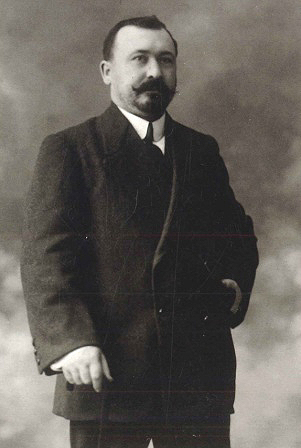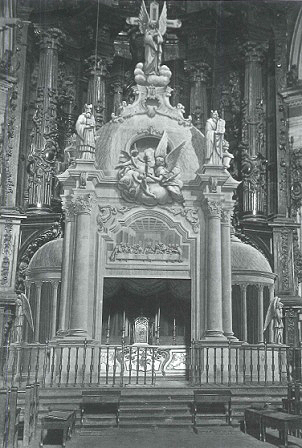The piece of the month of October 2015
A WORK BY FRANCISCO SÁNCHEZ MORENO IN LERÍN:
THE MONUMENT OF HOLY WEEK OF 1918.
Alejandro Aranda Ruiz
PhD student in Art History
There is no doubt that the Holy Week monument is one of the most representative expressions of the so-called ephemeral art. From the Latin monumentum, the monument was a sort of altar provisional adorned with magnificence and splendor where the Blessed Sacrament was reserved on Holy Thursday. The purpose of the reservation was none other than to enable communion on Good Friday, when there was no consecration, and to exalt the real presence of Christ in the Eucharist, whose institution is commemorated on Holy Thursday. Art and artists, especially since the Baroque period, contributed to the design and construction of these altars, giving rise to different typologies: perspective monuments, turriform and pyramidal constructions. The case of Navarre was no exception in this respect. During the 18th century and well into the 19th century, perspective monuments were especially popular in these lands. These constructions had a succession of decreasing arches that generated a sensation of depth in the eyes of the spectator. The traces of José de Lesaca for the monument of the parish of Lerín (1732) and the monuments of the cathedral of Pamplona (1743), Los Arcos (1763), Lodosa (1770), San Saturnino de Pamplona (1778), Miranda de Arga (1768) and Peralta (1781) were ascribed to this typology.
Contrary to all appearances, the example in question here does not belong to the Baroque centuries but to a date as late as 1918. As with other works of the same genre, this monument fell victim to fire in the middle of the 20th century. Deterioration, changes in fashion, and the consequences and misinterpretations of the Vatican II liturgical reform caused the disappearance of almost all of the ancient monuments. A photograph and a brief reference letter in the book of the parish's factory board have allowed its documentation. The photograph had already been published on some occasions, but the exact chronology and the author of the monument were unknown. The factory book reveals that in 1918, when Don Pablo Ciriza was parish priest, 4,000 pesetas were given "to D. Francisco Sánchez for a monument for Holy Week". Likewise, 40 pesetas were given to "Mr. Julián Sánchez for bringing it from Pamplona", in addition to another 201.50 pesetas for a carpenter for the materials for the frame and its installation in the presbytery.
Thus, the factory book indicates that the monument was made in the capital of Navarre by a painter named Francisco Sánchez. This artist could have been none other than Francisco Sánchez Moreno, a famous painter from the beginning of the 20th century, born in Lerín and settled in Pamplona. Very little is known about the professional career and staff of Francisco Sánchez. As far as his training is concerned, it is known that he studied with the Piarists of Alcañiz and that in 1891 he began his artistic programs of study in the School of Arts and Crafts of Pamplona, quickly standing out for his good gifts. There he received a classical and academic training where drawing and copying models were the fundamental basis of learning. During his phase at training he would make the collection of drawings preserved in the Museum of Navarre and dated between 1891 and 1893 in which the author from Lérin reproduced decorative motifs and landscapes with romantic resonances. According to Martín Cruz, Sánchez Moreno left evidence in the scarce work preserved of "a good command of drawing, of the breadth of his work, from portraits, landscapes and still lifes to mural painting". The drawings in the Museum of Navarre and the characteristics of the monument in Lérin corroborate these statements. The descriptions of the paintings that the artist made in 1915 for the barracks of the military forces stationed in Estella also shed some light on his style and characteristics. Diario de Navarra stated that Sánchez Moreno "if he were not already well accredited for his artistic taste, it would be enough to see the magnificent tapestries he painted representing scenes of the Flanders period, as well as the other works of painting, all of them of irreproachable taste and careful execution. We congratulate, then, Mr. Sánchez, wishing him many works, where he can show off his artistic hobbies"(Diario de Navarra, 15/09/1915). These painted tapestries were located in the flag room of the barracks and they copied scenes alluding to the Flanders tercios (Diario de Navarra, 13/09/1915). In final, a painting of classical and academic taste, well executed and very attached to the models of tradition, models from which the painter drank during his training.

Francisco Sánchez Moreno, c. 1910
As far as his life staff and professional life is concerned, Francisco Sánchez was married to Margarita Cayuela Esparza from Tafalla, with whom he had three sons, one of whom, Emilio Sánchez Cayuela "Gutxi", followed his father's official document as a painter. After having run with his partner Francisco Ibáñez a wallpaper, painting and decoration store in Zapatería Street, in 1915 Sánchez Moreno opened his own store at issue 12 Eslava Street under the name of "Casa F. Sánchez" and the local press wished him "much prosperity in his new establishment"(Diario de Navarra, 11/06/1915). It was precisely in these premises where the "Navarra Artística" (Artistic Navarre) was based, a gathering that brought together the best of Pamplona's society, art, culture and intelligentsia of those years with personalities such as the architect Víctor Eusa, the artists Inocencio García Asarta, Enrique Zubiri, Milán Mendía, Javier Ciga or Jesús Basiano. Likewise, as his son Emilio Sánchez Cayuela recalled, in that store "there was everything, colors for painters, canvases, plates, collections of artistic postcards, moldings, wallpapers... being the foreign suppliers because at that time, except for something in Barcelona, there was little national". Undoubtedly, many of these plates and postcards served as model for the works of the artist from Lerna.
Thus, as far as the Lerín monument is concerned, it, like its Baroque predecessors, consisted of a large painted curtain supported by a wooden frame that year after year was erected in the presbytery of the parish. The machine had a central opening from which the main altar with the tabernacle could be seen. The fabrics and the frame reproduced a great templete of Borrominesque taste composed by a central body supported by four columns of Corinthian capital on which ran a powerful entablature. On both sides of the central body were attached two small temples with cupolas and Corinthian columns. The whole of the monument was topped by a dome of average orange. The iconography represented in the machine was destined to emphasize and exalt the mystery of the Eucharist. On the lintel of the access door to the tabernacle one could read in Latin Cum dilexisset suos in finem dilexit eos, that is, as he loved his own he loved them to the end. This sentence, taken from the fragment of St. John's Gospel that was read at Holy Thursday Mass, emphasized the sacrificial character of the Eucharist. Above this registration was a reproduction of the well-known representation of the Last Supper that Leonardo da Vinci made between 1495 and 1498 for the refectory of Santa Maria delle Gracie in Milan. Also, at the top of the dome, there was a glory break with an angel carrying a chalice in allusion to the episode lived by Christ in the Garden of Olives after the Last Supper. On both sides of the dome the images of Aaron as high priest and Moses with the tablets of the Law were identified. The two, prefigures of the Eucharist and exponents of the old cult and the old law surpassed by Christ, priest of the new cult and the new law. The angelic motifs, so closely linked to the Eucharistic cult, also found their place in this monument with representations of angels at the end of the gallery of columns of each of the lateral temples and at the top of the dome.

Easter Week Monument of Lerín, 1918
(Photograph c. 1960)
From the compositional point of view, the work is a compendium of the Western artistic tradition with influences ranging from the Italian Renaissance (Last Supper) to the Roman Baroque (dome, architectural orders). This monument is a confirmation of the academic and traditional training of its author. Likewise, its configuration refers directly to the Baroque monuments of perspective formed by painted architectural canvases and confirms once again the survival of forms and tastes typical of the Ancien Régime in plenary session of the Executive Council 20th century. The maintenance of the Tridentine liturgy until the 1960s and the conservatism in the forms of religiosity and artistic tastes of Navarre at the time explain such a commission.
SOURCES AND bibliography:
-ALEGRÍA GOÑI, C., "Pintores Contemporáneos I", El Arte en Navarra 2. Renacimiento, Barroco y del Neoclasicismo al arte actual, Pamplona, Diario de Navarra, 1994, pp. 378-392.
-file Parroquial de Lerín, Libro de cuentas de la board de Fábrica de la villa de Lerín, cuentas del año de 1918.
-ECHEVERRÍA GOÑI, P.L., "Los monumentos o "perspectivas" en la escenografía del siglo XVIII de las grandes villas de la Ribera estellesa", Príncipe de Viana, nº 190, Pamplona, Príncipe de Viana, 1990, pp. 517-532.
-MARTÍN CRUZ, S., Emilio Sánchez Cayuela "Gutxi", Pamplona, Caja Navarra, 2001.
-REDÍN ARMAÑANZAS, A.E. and MARTÍN CRUZ, S., Francisco Sánchez Moreno. Drawings, Pamplona, Government of Navarra, 2000.
